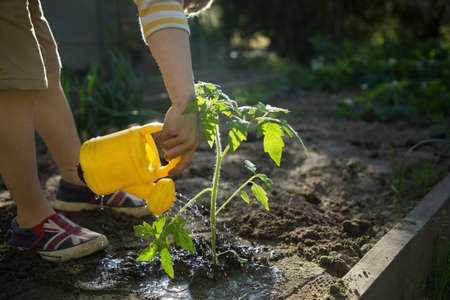1. Understanding the English Climate and Water Scarcity
In recent years, many families across the UK have noticed that their gardens are facing new challenges. Rainfall patterns are shifting, with longer dry spells and sudden downpours becoming more common than the gentle, reliable showers we once expected. Temperatures too are creeping upwards, changing the rhythm of growth for our beloved plants. This is all part of a larger story – climate change is gently but persistently reshaping what it means to be an English gardener. Where once roses thrived in moist soil and lush lawns were a staple, we now must consider how best to nurture our green spaces in the face of water scarcity. By understanding these changes and working together as a family, we can learn from nature’s own resilience and create gardens that continue to blossom beautifully, even when rain is scarce.
2. Selecting Drought-Tolerant Plants for British Gardens
Choosing the right plants is at the heart of designing a drought-resilient English garden, especially as our seasons grow warmer and drier. Both native and well-adapted non-native species can thrive in British soil with minimal water, lending beauty and vibrancy to your borders even during dry spells. Let’s explore some excellent plant options and practical tips for creating colourful, resilient displays that flourish with less fuss.
Native and Non-Native Plant Choices
Native plants are naturally suited to local conditions and tend to require less maintenance once established. However, many non-native species have proven their mettle in UK gardens, offering bold textures and colours while coping admirably with limited water. Here’s a handy comparison table of drought-tolerant stars:
| Type | Plant Name | Features | Flowering Season |
|---|---|---|---|
| Native | Eryngium planum (Sea Holly) | Spiky blue flowers, attracts pollinators | Summer |
| Native | Verbascum nigrum (Dark Mullein) | Tall yellow spikes, wildlife-friendly | Summer–Autumn |
| Non-Native | Lavandula angustifolia (English Lavender) | Scented, evergreen, bee favourite | Summer |
| Non-Native | Echinops ritro (Globe Thistle) | Bold blue globes, architectural interest | Mid–Late Summer |
| Non-Native | Sedum spectabile (Ice Plant) | Pale pink blooms, succulent leaves | Late Summer–Autumn |
| Native | Achillea millefolium (Yarrow) | Flat flower heads, feathery foliage | Summer–Early Autumn |
| Non-Native | Cistus x hybridus (Rock Rose) | Papery white flowers, sun-loving shrublet | Spring–Early Summer |
| Native/Hybridised Forms Available | Dianthus deltoides (Maiden Pink) | Mats of bright pink blooms, low-growing groundcover | Late Spring–Summer |
Cultivating Vibrant, Resilient Borders: Practical Tips
- Diversify Your Palette: Mix perennials, grasses and sub-shrubs to ensure year-round interest and resilience. Try weaving together different heights and forms for a natural look.
- Create Microclimates: Use rocks, gravel paths or larger shrubs to shield delicate plants from drying winds and create pockets of shade.
- Mulch Generously: Apply organic mulch such as bark chips or leaf mould around your plants each spring to lock in moisture and suppress weeds.
- Avoid Overcrowding: Give each plant enough space so roots can spread deeply—this encourages them to withstand dry periods better.
The Parent-Child Planting Moment: Learning Together
Sow seeds or plant young specimens together with your children. Chat about how some plants have furry leaves or deep roots as clever tricks for holding onto water—nature’s way of teaching us resilience! Watch as each plant grows strong in its own unique style, just as every family member brings their special strengths to your home garden.
Nurturing a Sustainable Future
Selecting drought-tolerant beauties isn’t just smart gardening—it’s an act of care for both our landscapes and future generations. By choosing plants that dance through dry weather with ease, you’ll create a garden that tells a story of hope, adaptation and harmony with nature—one border at a time.

3. Soil Improvement and Mulching Techniques
When it comes to nurturing a drought-resilient English garden, the secret often lies beneath our feet. Improving your soil’s structure is like giving your garden’s roots a supportive hug—one that helps them store precious moisture during dry spells and encourages healthy growth, much like how we support each other through challenging times.
Building Better Soil for Resilience
English gardens are traditionally known for their lush borders and vibrant beds, but these charming displays can struggle without water-retentive soil. Begin by incorporating well-rotted organic matter such as compost or leaf mould into your beds. This not only enriches the earth with nutrients but also boosts its ability to hold onto moisture—much like a sponge soaking up a summer shower. Regularly digging in organic matter, especially in autumn and spring, helps create that crumbly, open texture that roots love.
Choosing the Right Amendments
If you’re dealing with heavy clay or sandy soils—a common challenge across many parts of England—you can further improve water retention by mixing in horticultural grit with clay or adding extra compost to sandy plots. Consider green manures or cover crops over winter; these help protect the soil surface from erosion and break down into humus, enhancing the soil’s ability to store water come summer.
The Magic of Mulching
Mulching is one of the most sustainable practices for keeping plant roots cool and hydrated during dry periods. In true British style, think of mulch as a comforting blanket tucking your plants in before a long nap. Apply a generous layer of organic mulch—such as bark chips, wood shavings, straw, or even grass clippings—in late spring when the soil is moist and warming up. Aim for 5–7cm thick, taking care to leave a little space around stems to prevent rot.
Sustainable Choices for Every Garden
For an eco-friendly approach, try using locally sourced materials: shredded prunings from your own trees or recycled mushroom compost from nearby farms. Not only does this reduce waste, but it also celebrates the cycle of life within your garden’s ecosystem. Over time, mulches break down and feed your soil, encouraging earthworms and other helpful creatures—a gentle reminder that small actions today nurture resilience tomorrow.
By investing time in soil improvement and embracing mulching traditions rooted in British gardening wisdom, you’ll be helping your plants weather future dry summers while fostering a thriving garden community—just like families supporting each other through sunshine and rain.
4. Water-Saving Garden Design Strategies
Designing a drought-resilient English garden calls for a blend of creativity and tradition, drawing upon both classic British charm and innovative water-saving solutions. By exploring thoughtful layout ideas such as rain gardens, gravel paths, and patio planting, you can create an enchanting outdoor space that thrives even during dry spells, while also nurturing family connection and curiosity about the natural world.
Rain Gardens: Nature’s Sponge
A rain garden is a beautiful, low-maintenance feature that captures and filters rainwater runoff, helping to reduce water waste and support plant health. Situated in a gentle dip or hollow, rain gardens can be planted with native moisture-loving species like iris, meadowsweet, and marsh marigold. This approach not only conserves water but also attracts pollinators—perfect for inspiring little explorers to observe the wonders of nature up close.
Gravel Paths: Classic Meets Practicality
Gravel paths are a staple of traditional English gardens, offering timeless appeal while promoting excellent drainage. Unlike impermeable surfaces, gravel allows rainwater to soak into the ground rather than run off. These winding walkways invite children and adults alike to wander through the garden, discovering new plants and hidden corners along the way. For extra resilience, consider edging your paths with drought-tolerant herbs like thyme or lavender, which release delightful scents underfoot.
Patio Planting: Stylish & Sustainable
Patios provide valuable social space for families to gather, play, and relax. To make your patio both stylish and sustainable:
| Feature | Drought-Resilient Options | Benefits |
|---|---|---|
| Pots & Containers | Terralotta planters with rosemary, sedum, or ornamental grasses | Easy to move; require less watering; add visual interest |
| Vertical Gardens | Wall-mounted pockets with ferns or succulents | Saves space; reduces evaporation; encourages creative planting with children |
| Paving Choices | Permeable pavers or reclaimed stone slabs | Allows rainwater absorption; eco-friendly aesthetic; blends with heritage themes |
Clever Plant Grouping & Mulching
Grouping plants according to their water needs simplifies care and prevents overwatering. For example, Mediterranean herbs such as sage, oregano, and rosemary thrive together in sun-baked corners. Layering mulch around beds not only locks in precious moisture but also provides endless opportunities for family learning—observe worms and insects at work beneath the surface!
Nurturing Family Connections Through Design
An English garden designed with drought-resilience in mind doesn’t have to sacrifice beauty or tradition. By embracing inventive layouts inspired by Britain’s gardening heritage—and inviting children into every step of planning and discovery—you can grow a living classroom where sustainability and togetherness blossom side by side.
5. Smart Watering Practices and Efficient Irrigation
In a classic English garden, every drop of water is precious—especially when drought becomes more common. Let’s gather together, like a family huddled around the kitchen table, and discover how to make the most of our water resources without compromising the beauty and spirit of our gardens.
Harvesting Rain: The Magic of Water Butts
Start by capturing rainwater—a time-honoured tradition in UK gardening. Installing water butts under your downpipes allows you to collect and store precious rainfall, which is not only free but also softer and kinder for your plants compared to tap water. With UK regulations encouraging sustainable solutions, many councils even offer subsidised water butt schemes. Teach little ones to help fill their watering cans from the butt, making it a daily ritual that connects them to the rhythms of nature.
Drip Irrigation: Precision for Parched Times
For those dry spells that test both patience and petals, drip irrigation systems provide a gentle, targeted way to water your plants directly at the roots. This method minimises evaporation and prevents overwatering—perfect for British beds brimming with thirsty perennials or vegetables. Choose kits that comply with UK hosepipe restrictions and use timers to ensure efficient use during permitted hours. It’s like giving each plant its own cuppa exactly when needed!
Mulching and Timing: Old-Fashioned Wisdom
Don’t forget traditional tricks—mulch beds with bark or compost to keep moisture locked in and reduce the need for frequent watering. Encourage your children to help spread mulch, turning chores into learning moments about conserving earth’s gifts. And always water early in the morning or late in the evening; this helps prevent rapid evaporation and fits perfectly with the relaxed pace of British summer evenings.
Blending Modern Tools with Local Habits
Combine these approaches with a keen eye on local guidance—many areas in the UK issue updates on drought conditions and watering restrictions. Make it a family habit to check local advice together before switching on the hose or filling up a paddling pool. By blending modern tools like rainwater harvesters and drip systems with beloved British gardening traditions, you’ll create an oasis that flourishes even through dry spells—nurturing both your garden and family bonds along the way.
6. Building Community and Family Engagement in Sustainable Gardening
Creating a drought-resilient English garden is not just about individual effort; it thrives on community spirit and the involvement of every generation. By inviting families and neighbours to participate in sustainable gardening projects, you nurture not only your plants but also strong bonds and environmental stewardship within your local area. Consider organising seasonal planting days, where everyone—from grandparents to little ones—can share stories, swap seeds, and learn traditional water-wise techniques passed down through generations.
Encouraging Hands-On Learning
Transform your garden into a living classroom by hosting educational workshops for all ages. Children can delight in scavenger hunts, discovering how mulching keeps the soil moist or why native wildflowers attract helpful pollinators. Meanwhile, adults might enjoy demonstrations on installing rainwater harvesting systems or creating wildlife habitats that flourish even during dry spells. These hands-on experiences inspire curiosity and responsibility, making every family member feel like a caretaker of the earth.
Garden Clubs and Local Initiatives
Joining or forming a neighbourhood garden club can help spread sustainable practices far beyond your own plot. Share drought-resistant plant cuttings, exchange tips on eco-friendly watering routines, or collaborate on larger projects such as community composting bins. Many towns across the UK have initiatives that support green spaces—get involved and encourage others to do the same. By working together, you create resilient landscapes that are both beautiful and beneficial to all.
Celebrating Success Together
Don’t forget to celebrate your achievements! Host an annual garden open day or harvest festival, inviting neighbours to admire the fruits of your collective labour. These gatherings foster pride, spark new friendships, and reinforce the importance of caring for our shared environment—rain or shine. By weaving community engagement into your sustainable gardening journey, you ensure that lessons of resilience and respect for nature will blossom for generations to come.


